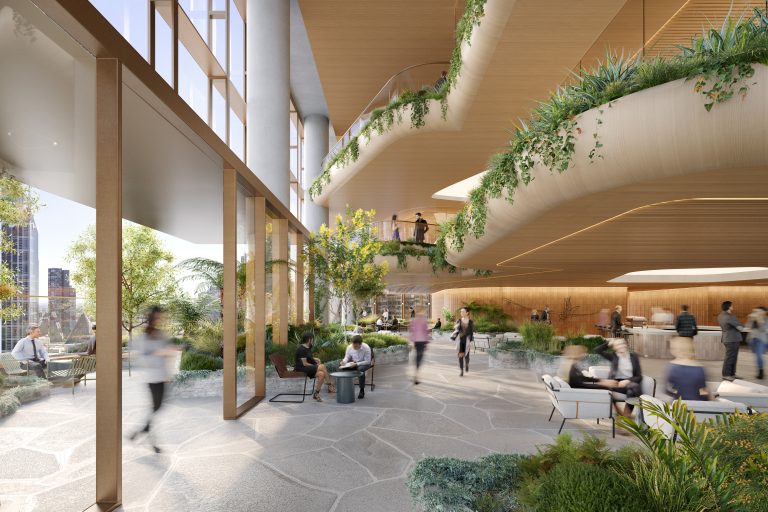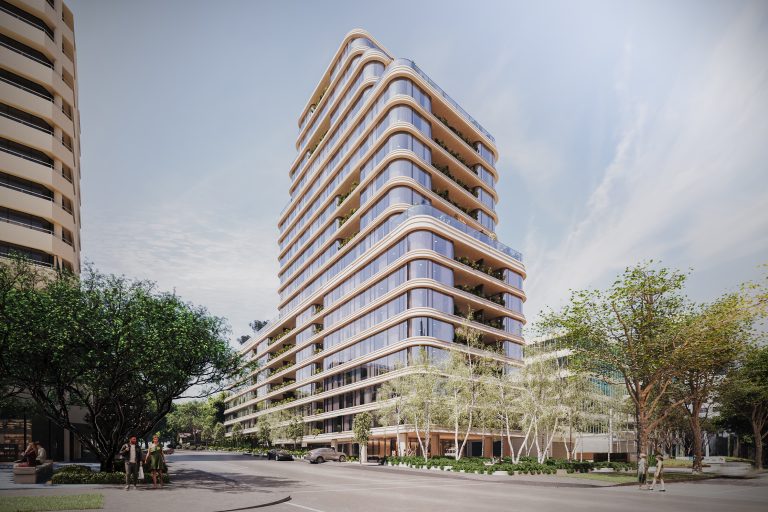16 Nov 2012
In with the old and in with the new as architect faces Collins Street challenge

IT’S an ambitious task: building Melbourne’s first premium-grade office building in more than 20 years on a small site, and integrating it with a 100-year-old building in the heritage heart of Collins Street. An added complication is that it will form a backdrop to St Paul’s Cathedral.
Architect Bates Smart is confident it has got the design right, as are the owners and developers-a joint venture between Charter Hall Office Real Estate Investment Trust (previously the Macquarie Office Trust) and Cbus Property.BHP-Billiton has already been snared as the anchor tenant.
The building will be at 171 Collins Street, tucked in behind the heritage-listed building know as the Mayfair (formely called the Auditorium) and its neighbour, Kurrajong House, and backing on to Flinders Lane. “With about a 26 metre frontage, we will have a clear and recognisable address on Collins Street, like No 1, 101, 120, 161, 171, and 333. We sit proudly and comfortably within that,” Charter Hall development director Carl Schibrowski told BusinessDay.
“We are building premium grade, a building to keep. They don’t trade very often, they are hard to buy. So the idea is to design, develop and build, and hold the asset.”
Mr Schibrowski said architect Bates Smart, which has been around for 160 years, was chosen because it designed buildings that were unashamedly modern, “but have a timeliness, a credibitily and integrity about them.” The design architect was Kristen Whittle.
A beautiful heritage building will greet the visitor. The former Auditorium building was designed in 1913 by Melbourne architect Nahum Barnet for the theatrical firm J&N Tait. It is eight storeys with a face brick and cement facade.
A huge central Romanesque archway dominates the front, with deeply set arched window openings, iron balconettes and intricate cornices. Heritage Victoria said the building’s style, dubbed American Romanesque, was significant as it marked a shift from the influence of Art Nouveau to a new form of classicism probably inspired by the decorated high-rise architecture of Louis Sullivan in Chicago.
Built as a musical hall, the Auditorium was converted to a cinema in the 1930s, and in the 1980s when it was transformed into a shopping complex, the original theatre was destroyed.
“The retail centre, the Shop of Shops, was opposite the old Georges, and tried to position in that space, but the retail did not connect to Flinders Lane, so there was not much foot traffic and did not work,” Mr Schibrowski said. Mayfair ended up on the list of Melbourne City Council’s problem sites.
Charter Hall bought the land behind the Mayfair and Kurrajong House, and consolidated it into a 3000 square metre site, with Flinders Lane to the south and Watson Place to the west. The site’s length is about 60 metres.
Bates Smart chairman Roger Poole said it was a challenge to put a landmark building on a constrained site. “It could never be what it is without the site. It’s designed for the context,” he told BusinessDay.
The building will be a 20-level office tower above an atrium lobby that will connect Collins Street to Flinders Lane.
The tower, which will be set more than 30 metres back from Collins Street, will have 17 occupiable office floors, the Mayfair will have seven boutique office floors, and five retail tenancies will front COllins and Flinders Lane.
Mr Poole said Bates Smart had managed to get the two buildings to work together through the atrium, which forms the back of the heritage building. “It deals with the side wall conditions -the existing buildings- and is designed to complement the facade of the new tower,”he said. “The atrium pulls everything together and makes the old and the new building work together.”
The building’s facade is designed to be fragmented into a series of inclined planes, each of which reflects or refracts the light in different ways. “Rather than a single monolithic surface, which is flat, the whole facade of the tower all the way up is gently undulating,” Mr Poole said. “Half of the elements face the sky slightly, and half are slightly inclined to the ground. The face is effectively a women facade.
“Instead of being a monolithic structure, it’s a woven structure.”
A frit -a small dot pattern of one millimetre dots – keeps the building visually light. “The efffet required the building to be lighter in colour than a normal glass building, many of which are quite dark. This one is visually light,” he said.
“What does that is the tiny frit or dot pattern. The frit can’t be seen from the inside, but reflects light from the outside and reduces heat and glare.”
The aim is to maintain the light colour even in conditions when it would get dark. Most importantly, Mr Poole said the frit would provide a quiet background to St Paul’s Cathedral – “like a piece of sky, an undulating curtain that comes down behind the building.: :Exact modelling demonstrated to the planning authorities that the building will have the appearance we have represented,” he said.
Mr Schibrowski said the Atrium would create a crucial north-south linkage. “Most sites in town hae a north-south linkage-the Block Arcade, Georges across the road. This block did not have that. We saw that as a key urban-planning device, a good contribution to the area, “he said.
The net lettable area will be about 33,000 square metres – 29,790 sq m in the tower, 1690 sq m in the Mayfair, and 1650 sq m of retail. The frontage to Flinders Lane will have a more contemporary look.
“We are seeking the right operator for a signature food and beverage offer there. Flinders Lane has a tradition of quality, ritzy eateries,” Mr Schibrowski said.
Boutique private wealth management finance firm Evans & Partners has taken a lease in the Mayfair building. “It will be contemporary, new office space, yet will have the heritage values they like. There will be a roof terrace there, a customer lounge, where a broker can host a client…a bit like the old tradition of going to the club,” he said.
BHP will take levels 12 to 18 as its global headquarters, but will also have an area in the lobby for a business lounge.
“This will leave us 17,000 sq m to go for the project. Inquiry is strong. In the premium end of the market, there is not a lot of vacancy – 4000-5000 sq m of contiguous space is almost non-existent in CBD,” he said. “We see ourselves in pretty good shape in finding the right fit of tenant.”
Mayfair aims to be a 6 Star Green Star design and as-built building, with a 5 Star NABERS energy rating. There will be 139 car spaces and 280 bicycle spaces.
Brookfield Multiplex has started construction, which is expected to cost $145 million. Scheduled completion is April 2013. When completed, the Mayfair is likely to be worth more than $260 million.


